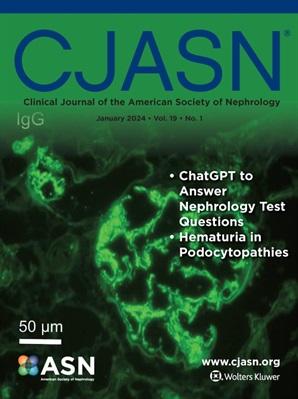Serum Metabolomic Markers of Dietary Potassium and Risk of CKD.
IF 8.5
1区 医学
Q1 UROLOGY & NEPHROLOGY
Clinical Journal of the American Society of Nephrology
Pub Date : 2025-05-01
Epub Date: 2025-03-11
DOI:10.2215/CJN.0000000675
引用次数: 0
膳食钾的血清代谢组学标志物与慢性肾脏疾病的风险
背景:发现膳食钾的代谢组学标志物可能有助于改善对钾的膳食评估,并追踪膳食钾对慢性肾脏疾病(CKD)发展的影响。方法:我们纳入了来自社区动脉粥样硬化风险(ARIC)研究的无CKD的成人(N = 3,812)。使用多变量线性回归模型评估膳食钾和血清代谢物之间的横断面关联。Cox回归模型估计了钾相关代谢物和CKD事件的风险比。CKD的发生率定义为肾小球滤过率(结果:膳食钾和血清代谢物之间有33个显著关联,包括吡脲酸盐、n -甲基脯氨酸、水苏氨酸、泛酸盐和三基肌醇。在超过20年的随访期间(中位数:23年,25 -75个百分点:14-30),1,616名(42%)参与者发展为CKD。33种钾相关代谢物中的10种与CKD的发生显著相关。参与苯丙氨酸和酪氨酸代谢的代谢物3-(4-羟基苯基)乳酸和3-苯丙酸与膳食钾和CKD显著相关。此外,参与葡萄糖代谢的甘油与膳食钾呈正相关(β=0.09, p=4.01 × 10-17),与CKD呈负相关(HR 0.77, 95% CI: 0.69-0.85, p=8.57 × 10-7)。在3-(4-羟基苯基)乳酸、3-苯基丙酸和甘油的四分位数中,CKD风险有显著趋势。结论:膳食钾与33种血清代谢物有关。3-(4-羟基苯基)乳酸、3-苯基丙酸和甘油是膳食钾对慢性肾脏疾病影响的候选标志物。
本文章由计算机程序翻译,如有差异,请以英文原文为准。
求助全文
约1分钟内获得全文
求助全文
来源期刊
CiteScore
12.20
自引率
3.10%
发文量
514
审稿时长
3-6 weeks
期刊介绍:
The Clinical Journal of the American Society of Nephrology strives to establish itself as the foremost authority in communicating and influencing advances in clinical nephrology by (1) swiftly and effectively disseminating pivotal developments in clinical and translational research in nephrology, encompassing innovations in research methods and care delivery; (2) providing context for these advances in relation to future research directions and patient care; and (3) becoming a key voice on issues with potential implications for the clinical practice of nephrology, particularly within the United States. Original manuscript topics cover a range of areas, including Acid/Base and Electrolyte Disorders, Acute Kidney Injury and ICU Nephrology, Chronic Kidney Disease, Clinical Nephrology, Cystic Kidney Disease, Diabetes and the Kidney, Genetics, Geriatric and Palliative Nephrology, Glomerular and Tubulointerstitial Diseases, Hypertension, Maintenance Dialysis, Mineral Metabolism, Nephrolithiasis, and Transplantation.

 求助内容:
求助内容: 应助结果提醒方式:
应助结果提醒方式:


